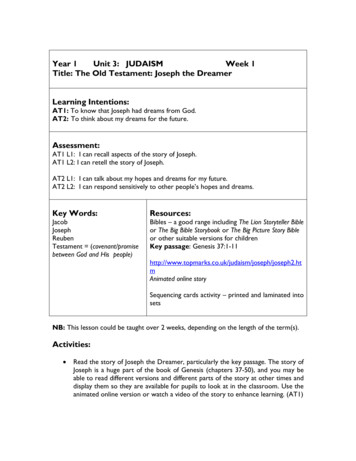
Transcription
Year 1Unit 3: JUDAISMWeek 1Title: The Old Testament: Joseph the DreamerLearning Intentions:AT1: To know that Joseph had dreams from God.AT2: To think about my dreams for the future.Assessment:AT1 L1: I can recall aspects of the story of Joseph.AT1 L2: I can retell the story of Joseph.AT2 L1: I can talk about my hopes and dreams for my future.AT2 L2: I can respond sensitively to other people’s hopes and dreams.Key Words:Resources:JacobJosephReubenTestament (covenant/promisebetween God and His people)Bibles – a good range including The Lion Storyteller Bibleor The Big Bible Storybook or The Big Picture Story Bibleor other suitable versions for childrenKey passage: Genesis seph2.htmAnimated online storySequencing cards activity – printed and laminated intosetsNB: This lesson could be taught over 2 weeks, depending on the length of the term(s).Activities:Read the story of Joseph the Dreamer, particularly the key passage. The story ofJoseph is a huge part of the book of Genesis (chapters 37-50), and you may beable to read different versions and different parts of the story at other times anddisplay them so they are available for pupils to look at in the classroom. Use theanimated online version or watch a video of the story to enhance learning. (AT1)
Laminate the sequencing cards and pupils can order the cards and recall/re-tellthe story of Joseph. Able pupils may be able to add speech bubbles to the cardsto denote speech and action. (AT1)Joseph was a dreamer. He had dreams from God about what would happen inthe future. What dreams do pupils have for their future? Encourage pupils tothink about what they would like to be when they grow up and what jobs theywould like to do. Pupils could illustrate their dreams for the future and displaythem. (AT2)
Joseph had 11brothers.He was given abeautiful coat byhis father,Jacob.Joseph was adreamer.He dreamt that hisbrothers’ cornbowed down to hiscorn.Joseph’s brotherswere angry and soldhim to be a slave inEgypt.Then Josephdreamt the sun,moon and elevenstars bowed down tohis star.
Joseph helpedPharaoh tounderstand hisdreams. Joseph hada very important jobin Egypt.Joseph wondered ifhis brothers hadchanged. Were theystill mean andjealous?Joseph’s brotherswere hungry so theycame to Egypt. Theydid not recogniseJoseph. They boweddown to ask him forfood.Joseph told hisbrothers who hewas and they werereunited. Jacobcame to Egypt tomeet them all.
Year 1 Unit 3: JUDAISMWeek 2Title: The Old Testament: Moses and the Ten CommandmentsLearning Intentions:AT1: To know that Moses led God’s people and gave them God’s Laws.AT2: To think about the laws and rules we have in our classroom.Assessment:AT1 L1: I can recall some of God’s rules.AT1 L2: I can also tell the story of how God gave them to his people.AT2 L1: I can talk about our classroom rules.AT2 L2: I can say which of our classroom rules I think are important.Key Words:Resources:BibleExodusMosesTen CommandmentsBibles – a good range including The Lion Storyteller Bibleor The Big Bible Storybook or The Big Picture Story Bibleor other suitable versions for childrenKey passage: Exodus 19:16 – /stories.php‘Forty Years’ tells the story of God’s people led by Moses andthe 10 es/moses14.htmFor KS1 – covers the whole of Moses’ life.‘The Ten Commandments for Children’ by Lois Rock(pub. Lion 1999 ISBN: 0 7459 3970 8)NB: Pupils will have read the story of Moses, the baby in the bulrushes, in Reception.The Old Testament book of Exodus follows Moses’ story including the burning bush, the10 plagues and the Hebrew slaves’ escape from Egypt by crossing the Red Sea. Godgives Moses the 10 Commandments during the 40 years of exile in the wildernessbefore they settle in Israel, the Promised Land. Try to read these stories at other timesand display them so they are available for pupils to look at in the classroom.
Activities:Read the story of Moses and the 10 Commandments from a children’s Bibleand/or follow the animated story of God’s people led by Moses in the link above(some of the vocabulary is KS2). Focus on each of the 10 Commandments andexplain they were God’s rules for God’s People. (AT1)Read each commandment and write out God’s 10 rules with pupils using theirown words and accessible language. Talk about rules and how they protect andguide people and help them to behave in the right way towards God and oneanother. (AT1)What rules do we have in our classroom? Why do we need rules? Which rule isthe most important? Pupils can use drama and act out different rules or create acharter of important class rules. (AT2)
Year 1 Unit 3:JUDAISMWeek 3Title: The Old Testament: Gideon – the braveLearning Intentions:AT1: To know that, although Gideon was scared, he was obedient to God.AT2: To think about when I have been brave and done the right thing.Assessment:AT1 L1: I can recall the story of Gideon.AT1 L2: I can retell the story of Gideon and say what was special about him.AT2 L1: I can talk about a time when I have been brave.AT2 L2: I can respond sensitively to other people’s experiences of being brave.Key Words:Resources:GideonIsraelMidianitesBibles – a good range including The Lion Storyteller Bibleor The Big Bible Storybook or The Big Picture Story Bibleor other suitable versions for childrenKey passage: Judges 7:1-22 and 6:15 (more aboutGideon in Judges ch. stories.phpGideon’s Little Army – animated story versionActivities:Encourage pupils to share a time when they have had to be really brave. What orwho helped them to be brave? What did they think about? How did they feel?Perhaps they can describe a time when they have had to do the right thing orstand up for themselves or another and they felt anxious about it. (AT2)Read the story of Gideon in Judges 6:15 and 7:1-22 from The Lion Storyteller Bibleor The Big Bible Storybook or another suitable version. Discuss the story toensure understanding. Talk about how Gideon must have felt when God askedhim to fight the Midianites, even though he was the youngest in his family (6:15).How did he feel when God said he only needed a little army of 300 soldiers?(AT1)
Pupils can cut out and paint torches, trumpets and large clay jars and make adisplay to tell this story. Pupils can use ICT to write out the words for each partof the story. Pupils could share this story in Collective Worship using musicalinstruments to make a loud noise with the rest of the school and talk about Godhelping Gideon not be afraid and to do the right thing for him. (AT1)
Year 1Unit 3: JUDAISMWeek 4Title: The Old Testament: Ruth – faithful and loyalLearning Intentions:AT1: To know the story of Ruth and why she is specialAT2: To think about when I have needed help from a faithful family member (or friend).Assessment:AT1 L1: I can recall aspects of the story of Ruth and Naomi.AT1 L2: I can retell the story of Ruth and Naomi.AT2 L1: I can say what family faithfulness (or friendship) means to me.Key Words:Resources:faithful true to one’s word; Bibles – a good range including The Lion Storyteller Biblereliable; trustedor The Big Bible Storybook or The Big Picture Story Bibleloyal faithfulor other suitable versions for childrenNaomiKey passage: Ruth chapter 1RuthBeads, wool / embroidery silks for friendship braceletsNB: The story of Ruth is very important in the Bible because her son, Obed, wasgrandfather to King David.Activities:Read the story of Ruth and Naomi in Ruth chapter 1. Ruth would not leaveNaomi, who was her husband’s mother. Even when Ruth’s husband died andNaomi grew old, Ruth stayed with her and God looked after them both. Theywent together back to Bethlehem where Ruth married Boaz and gave birth totheir son, Obed. Ruth showed great faithfulness. Discuss with pupils what thisword means. (AT1)Encourage pupils to think about family loyalty or faithfulness. Tell a story aboutsomeone making fun of your brother or sister or friend. How would you feel?What would you do? How would you show loyalty and faithfulness? (AT2)Pupils can illustrate these examples of family faithfulness and what it means tothem. They could write a sentence underneath, beginning, ‘I think that faithfulfriends/family are those who ’ (AT2)
Pupils could be shown how to make cut-outs of the figures in their families – alljoined together when opened out. (AT2)Pupils could make ‘friendship bracelets’ for a member of their family from beadsor plaited wool. They could give them with a message saying why their friendshipis so important to them. (AT2)
Year 1Unit 3: JUDAISMWeek 5Title: The Old Testament: Jonah the MoanerLearning Intentions:AT1: To know the story of Jonah and that Christians believe God is everywhere.AT2: To think about when I have been disobedient.Assessment:AT1 L1: I can recall the story of Jonah.AT1 L2: I can retell the story of Jonah and say what it helps Christians to remember.AT2 L1: I can talk about when I have been disobedient.AT2 L2: I can recognise that it was wrong to disobey.Key Words:Resources:disobedientJonahobedientBibles – a good range including The Lion Storyteller Bibleor The Big Bible Storybook or The Big Picture Story Bibleor other suitable versions for childrenKey passage: Jonah ch. 1 & 2 (the story continues inch. 3 & 4)Book resource:‘Jonah the Moaner’ Nick & Claire Page (pub. AuthenticMedia 2006 ISBN: 1 85610 235 ories.phpJonah and the Big FishWhale-shape cut outs for prayer activityActivities:Read the story of Jonah from a good children’s Bible and / or use the animatedversion online. Discuss with pupils the reasons why Jonah was disobedient andran away from God. Have pupils ever run away because they don’t want to dosomething or because they have done the wrong thing? (AT1/2)
Talk about what happened to Jonah in the belly of the big fish. Jonah prayed toGod inside the big fish and God was with him, even in there. Christians believeGod is never far away from them and they can never run away from Godbecause he is everywhere. (AT1)Pupils can write prayers saying ‘sorry’ to God for their disobedience orwrongdoing or they could write a prayer asking God to be near them. Theycould write them on whale-shapes to help them remember the story of Jonah.(AT2)
Year 1 Unit 3: JUDAISM Week 2 Title: The Old Testament: Moses and the Ten Commandments Learning Intentions: AT1: To know that Moses led God's people and gave them God's Laws. AT2: To think about the laws and rules we have in our classroom. Assessment:
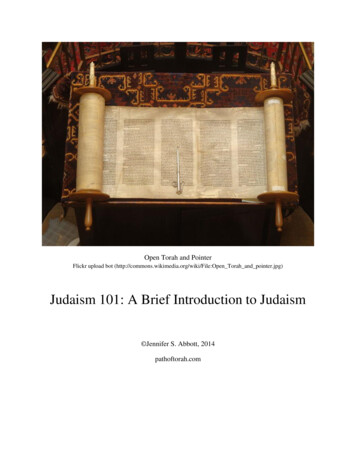
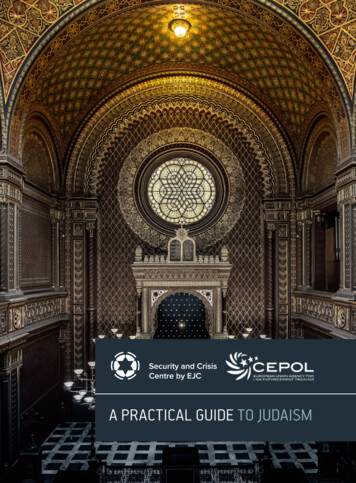
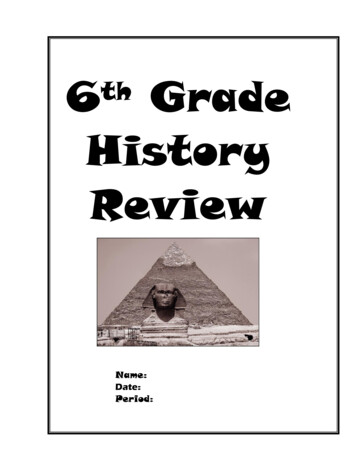
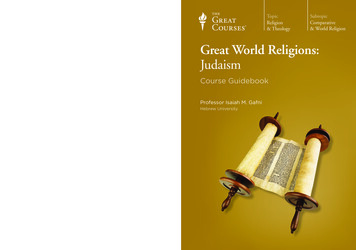

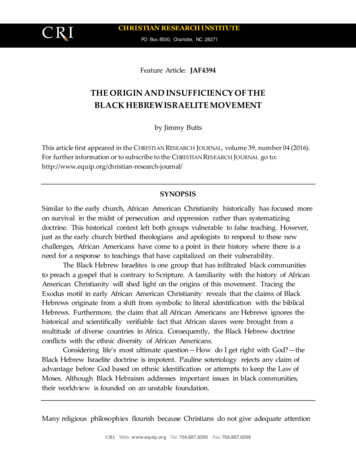

![[Goodman Martin] Judaism in the Roman World](/img/16/goodman-2007.jpg)


